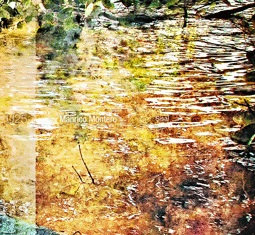 Location is integral to Manrico Montero’s Sisal, as it is with virtually all of the albums released on Unfathomless. Without it, there is still music, but the context and inspiration driving it is at least partially effaced. Sisal is both the common name for Agave sisalana, a species of agave cultivated for the fibers it yields, and the name of a small port town located in the Yucatán Peninsula, where said fibers play a significant role in the economy. But the album focuses on another species native to the region. With just one exception, each of its tracks are named for the mangrove trees that grow in a nearby area called La Bocana ("The Mouth"), where seawater meets the freshwater of a cenote. Montero’s recordings capture plenty of maritime activity around these trees, including the rocking of ship hulls, strong coastal winds, and a multitude of insect and animal life. They also expose sounds that are not ready-at-hand, that are a part of the place without appearing as such.
Location is integral to Manrico Montero’s Sisal, as it is with virtually all of the albums released on Unfathomless. Without it, there is still music, but the context and inspiration driving it is at least partially effaced. Sisal is both the common name for Agave sisalana, a species of agave cultivated for the fibers it yields, and the name of a small port town located in the Yucatán Peninsula, where said fibers play a significant role in the economy. But the album focuses on another species native to the region. With just one exception, each of its tracks are named for the mangrove trees that grow in a nearby area called La Bocana ("The Mouth"), where seawater meets the freshwater of a cenote. Montero’s recordings capture plenty of maritime activity around these trees, including the rocking of ship hulls, strong coastal winds, and a multitude of insect and animal life. They also expose sounds that are not ready-at-hand, that are a part of the place without appearing as such.
There is a temptation to connect field recordings with documentaries. It’s an impulse compelled by the sense that field recordings are uncontrived compared to conventional music, which requires instrumentation and a high degree of human intervention. But documenting and repeating the sounds of nature requires just as much mediation as does strumming a guitar or playing a keyboard. For one thing, Montero’s subjects are precise. He consciously hides as much as he reveals. For another, though he tries to mask it in different ways, his subjects are edited together and presented not as an unaltered image of a place, but as a carefully constructed simulacrum of it.
Montero’s concern is not fidelity, it’s evocation and correspondence. These are the places he wanted to represent in the way he wanted to represent them. There is an aesthetic of the hidden in his work, evidenced in the above-water and below-water soundscapes found on "Litoral Nor-Poniente" and "Cuarto Manglar," and there is also an emphasis on the pleasure of listening: to the movement of water and to the life that thrives around it. Even if the specifics are foreign, there will be something familiar about these vignettes—maybe in the rise and fall of chirping crickets or maybe in the patter of rain on glass and the crack of distant thunder. What is far away is drawn closer and that closeness registers as a kind of geographic harmony. The apparently foreign in fact shares a common root.
On "Mangle Negro," Montero pairs heavy winds and rain with something that sounds like the child of a creaky floorboard and a party balloon. Someone moves about the scene as the storm gains strength and blows through the leaves outside, but their activity ultimately merges with the aeolian din. There is no way of knowing whether it all happened in real time or whether Montero slapped two recordings together and carefully disguised the seams. Either way, a continuity beyond the documentary emerges because the flow of time and the necessity of proximity are eliminated. Listening to the echoes and percussive spikes on "Cuarto Manglar," the continuity from man to machine to nature is rendered with a kind of minimal clarity, even as the activity of the music remains mysterious.
samples:
 
Read More

